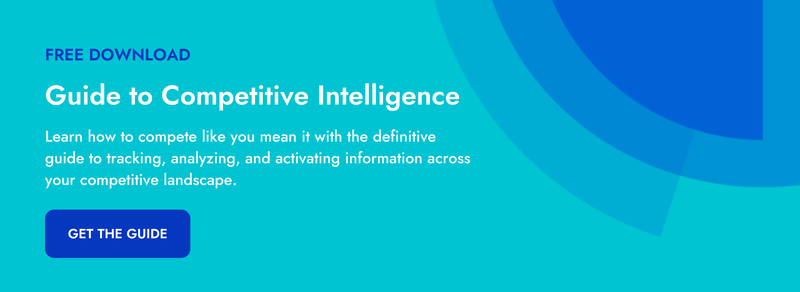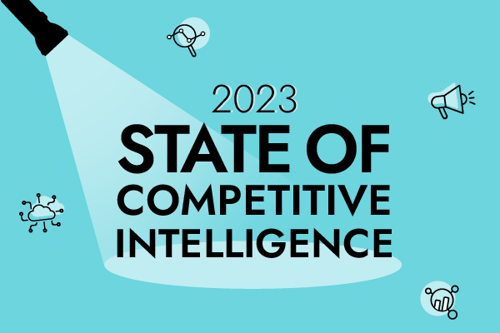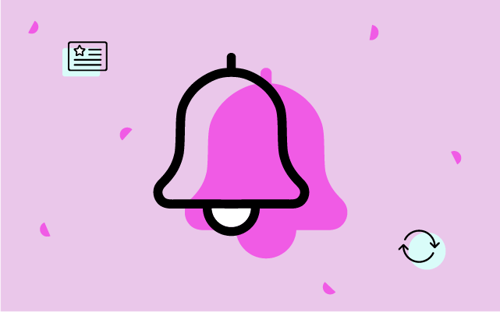There are many sources of competitive intelligence (CI) that we can tap into. These days, most businesses have a robust digital footprint, so our first thought of a valuable CI source is likely a company website. There are thousands of sources on the web that can tell us a lot about our competition, including, but not limited to, social media channels, third-party review sites, and news outlets. But, what about the sources that aren’t available on the web? In fact, one of the most valuable but hidden sources of competitive intelligence is right next to you – your coworkers.
Your coworkers know a lot about your competitors and are oftentimes the first to know about a new competitive development. Not only are your coworkers well-versed in your competitive landscape to best support your customers, win more competitive deals, shape the product roadmap, and resonate with your market, but your coworkers have access to exclusive knowledge that might not be visible on the web.
We classify this type of intel as Field Intelligence. Field Intelligence is simple: it’s competitive intelligence information that your team has gathered in the field at events, from prospects throughout the sales process, or from customers that add value to your competitive intelligence.
Let’s take a look at how you can source competitive intelligence information from your coworkers and leverage those insights in your competitive intelligence strategy.
Sources of Field Intelligence
Your colleagues are often talking about your competitors and discussing newfound insights with their teams. It’s unfortunate that sometimes, that intel doesn’t make it all the way to the competitive intelligence practitioner or product marketing manager. But, there are multiple ways to ensure that you can gather intel from your coworkers.
Ask Your Team
One easy way to gather field intelligence from your coworkers is to simply ask your teams if they have any new insights. Join in on weekly meetings or regularly scheduled calls. Open up a conversation with each team, as everyone has different interactions with your market.
- Your sales team is talking to prospects day in and day out, so they likely hear competitive objections, claims, and new pieces of insight daily. It’s no secret that prospects analyze more than one solution before making a buying decision. If your prospect is sharing information that they’ve seen in a demo from one of your competitors or heard from a sales rep at another company, your sales team should be taking notes and sharing these interactions with everyone else.
- Your customer success team is working directly with your customers. Although you’ve already won their business, that doesn’t mean your competitors aren’t reaching out to try and steal that business. If you have good relationships with your customers, they might even be sharing the sales pitches they’re getting from your competitors. Your customer success team can share these emails with you and your team to give you insight into your competitor’s sales strategy, and potentially give insight into what your competitors are working on.
- Your product team also works closely with customers, sometimes with a select group of customers, sometimes known as a Customer Advisory Board (CAB). These customers are oftentimes your happiest customers who would be strong advocates for your company and product. With that being said, if your customers found out intel about a competitor’s product or future product roadmap, they’d likely share this intel with your team.
- Your marketing team has access to many sources of intel across the web, even beyond traditional sources. Your marketing team is involved in communities, social networks, and is attending events both virtual and in-person. The important intel comes not from your competitors but rather from what people are saying about your competitors. Maybe someone mentioned your competitor on social media or within a forum, your competitor responded to a tweet, or someone at an event was talking about a competitor. These are excellent sources of field intelligence that you should take advantage of.
Gather Intel Where the Conversation is Happening
As previously mentioned, your coworkers are already talking about your competitors; they just might forget to communicate that information all the way to you. Just because you haven’t heard the conversation directly from your coworkers (yet) doesn't mean you can’t tap into the insights. Your coworkers are communicating with one another on multiple platforms, including your sales enablement platforms (Highspot, Seismic, etc.), your internal chats (Teams, Slack), and your CRM (HubSpot, Salesforce, etc.).
Conversations about your competitors are happening everywhere across your organization, and you’re likely missing most of it. Tapping into this source of intelligence across platforms will help you gather insights that you never otherwise would have, and it can be the difference between a won or lost deal, a decision to pivot your product roadmap, etc. The key thing to remember is that while you gather all of this intelligence that it’s going back into one system of record—nothing will kill your CI impact like disorganized intelligence.
Encourage Your Coworkers to Communicate Through Email and Chat
If you want to encourage your coworkers to share field intel directly with your CI and/or Product Marketing team, create an easy email distribution list or chat channel. That way, when someone uncovers an important piece of field intelligence, they can send it directly to your team. This cuts out the need to source the intel within your org and opens up communication between teams.
When it comes to an internal chat about competitive intelligence, such as a Slack channel, it helps if you have a two-way integration. That way, when someone shares field intel, they can easily add that piece of intel to your competitive intelligence database. Additionally, when that new piece of intel is added, it can be communicated out to the rest of your team.
How to Leverage Field Intelligence
Now that you’ve sourced and collected your field intelligence from your coworkers, there are three more steps you should take. First, validate the data. Second, share the data. And third, give a shoutout.
Validate the Insights
Field intelligence is an excellent way to enhance your competitive intelligence data. However, there are some instances where field intelligence may be inaccurate or out-dated, and that’s the last thing you want to communicate out to your teams. Arming your team with inaccurate insights can be costly to your organization, which is why when you gather a piece of field intel, you should validate the claim before disseminating it with your team. Check with additional stakeholders, search through your competitive intelligence platform for insights in line with your latest piece of field intel, or do a quick search on your competitor’s website to confirm the data.
Share the Insights
Once you’ve collected and validated your field intelligence, you need to get that intel in front of your team. Whether you’re incorporating the intel into a battlecard, sharing a competitive report, or simply pushing a singular insight out to the team, you want to get your findings out. That way, your team can begin leveraging this new intel as soon as possible.
Each of your key stakeholders consumers intel differently. When you share intelligence, you want to share it across multiple platforms in order to increase the chance that the intel is being acted on. If you share your competitive intelligence update across Slack (or other chat apps), your CRM, email, and your sales enablement platform, you’ll have the highest chance of your competitive intel being accessed and consumed.
Give a Shoutout
Field intelligence is a critical component of your competitive intelligence strategy. If you have a colleague who is providing you with field intelligence, be sure to give them a shoutout. This way, they’ll know you’re listening to their insight, hear that their tip is impactful, and feel encouraged to continue sharing intel with you. Plus, this encourages the rest of your organization to contribute, too.
With so many sources of competitive intelligence available to us, field intelligence from our coworkers is only a small yet very important piece of the puzzle. These insights are often golden nuggets of intel that can potentially have a major impact across your organization, including sales winning a big deal, product making a key roadmap decision, or the c-suite making a crucial change to the company vision. Take advantage of the competitive intelligence resources you have inside your organization to ensure that your CI is having real business impact.

Related Blog Posts
Popular Posts
-
 How to Create a Competitive Matrix (Step-by-Step Guide With Examples + Free Templates)
How to Create a Competitive Matrix (Step-by-Step Guide With Examples + Free Templates)
-
 The 8 Free Market Research Tools and Resources You Need to Know
The 8 Free Market Research Tools and Resources You Need to Know
-
 Sales Battlecards 101: How to Help Your Sellers Leave the Competition In the Dust
Sales Battlecards 101: How to Help Your Sellers Leave the Competition In the Dust
-
 6 Competitive Advantage Examples From the Real World
6 Competitive Advantage Examples From the Real World
-
 How to Measure Product Launch Success: 12 KPIs You Should Be Tracking
How to Measure Product Launch Success: 12 KPIs You Should Be Tracking





